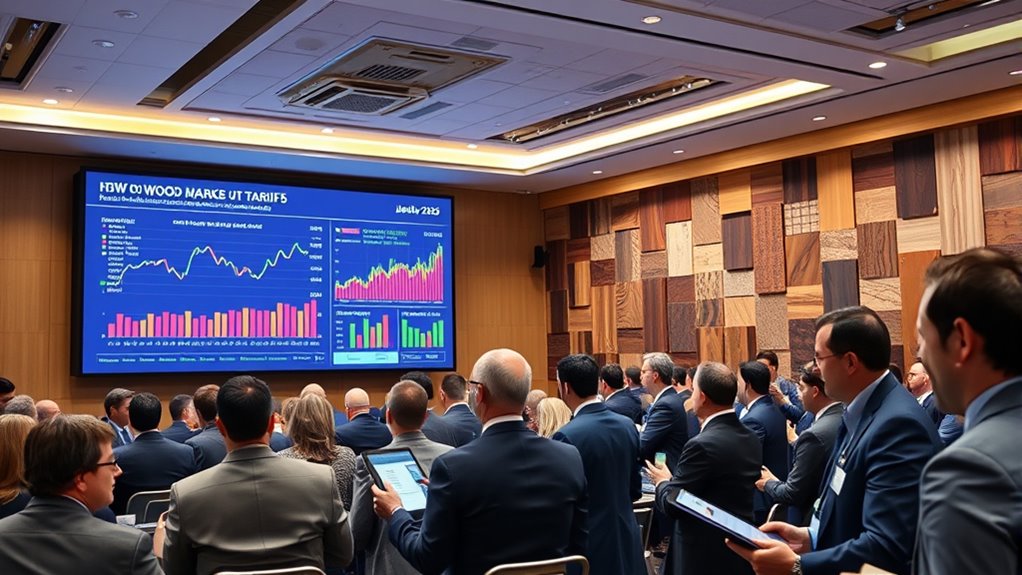In 2025, tariff discussions considerably impact wood product markets, creating uncertainty and price swings. Tariffs on Canadian softwood lumber fluctuate, with rates potentially rising to 27% or more. These volatile policies disrupt supply chains and make long-term planning difficult. Industry players are adjusting strategies and seeking alternative markets to navigate the shifting landscape. If you want to understand how ongoing policies could affect costs and availability, there’s more to explore below.
Key Takeaways
- Ongoing tariff fluctuations create market uncertainty, causing volatile wood prices and impacting supply chain stability in 2025.
- Tariff rates on Canadian softwood lumber fluctuate between 14.54% and potentially over 27%, affecting export competitiveness.
- Trade policy negotiations, including USMCA and Section 232 investigations, influence tariffs and market access for wood products.
- Industry stakeholders are lobbying for tariff relief, adjusting production, and exploring alternative markets to mitigate impacts.
- Market volatility driven by tariff discussions hampers long-term planning, investments, and profitability in the wood product sector.

In 2025, tariff discussions continue to shape the wood markets, creating uncertainty for industry stakeholders. You’re likely feeling the ripple effects of these ongoing debates, especially as tariffs on Canadian softwood lumber remain a key factor influencing market stability. Recent policy decisions, including temporary reprieves and the threat of potential tariff hikes, contribute to this instability.
These fluctuations make it challenging for you to plan investments or manage supply chains confidently. When tariffs change, prices can swing dramatically, leading to volatility that hampers market confidence. You might notice prices rising sharply under certain tariff scenarios, with projections indicating increases of up to 21% this year. Such swings can catch businesses off guard, impacting profitability and long-term planning. Additionally, the unpredictable nature of these tariffs underscores the importance of understanding trade policy dynamics to navigate market risks effectively.
Trade agreements, notably the U.S.-Mexico-Canada Agreement (USMCA), play a noteworthy role in shaping tariff policies. You should stay informed about how these agreements evolve since they influence export opportunities and tariffs’ application. The ongoing evolution of trade policies means you have to adapt constantly, whether through lobbying efforts, strategic planning, or adjusting your sourcing strategies.
The threat of reinstated or increased tariffs injects a layer of unpredictability, prompting many industry players to brace for further shocks. Some companies are responding by lobbying for relief or seeking alternative markets to mitigate risks tied to tariff fluctuations.
The softwood lumber industry feels the impact acutely, with weak market conditions already present due to broader economic factors. Tariffs exacerbate these challenges, affecting both Canadian exporters and U.S. importers. If tariffs rise as predicted, prices could jump notably, creating a squeeze on your margins and altering demand patterns. Additionally, the fluctuating tariff rates can influence broader economic conditions that affect your business’s growth and sustainability.
This uncertainty leads many to hold back on inventory investments or delay expansion plans, fearing further price swings. Meanwhile, industry responses include adjusting production levels and strategizing to withstand potential supply disruptions caused by tariffs and supply chain issues.
Tariff rates are a moving target. Currently, the rate on Canadian lumber sits at 14.54%, but there’s a real possibility it could climb to 27% or higher by late 2025. The Section 232 investigation into national security concerns could also push for additional tariffs or quotas, adding more complexity. The investigation has already led to certain tariffs being implemented or maintained. Recognizing the importance of market stability can help you better prepare for future fluctuations and safeguard your operations.
Temporary exemptions under USMCA have offered some relief, but these are limited and may not last long. Negotiations are ongoing, with industry groups lobbying to stabilize or reduce tariffs, but the landscape remains uncertain. For you, staying agile and well-informed is essential to navigate the shifting policy environment, manage costs, and safeguard your business against potential disruptions. Additionally, the tariff policies can influence broader economic conditions that affect your business’s growth and sustainability, making it crucial to monitor developments closely.
Conclusion
As tariff talks unfold like a tightrope walk over a stormy sea, your wood product markets hang in the balance. Every decision is a ripple shaping the waves ahead, and your choices could steer the ship toward calmer waters or turbulent storms. Stay alert, because in this game of trade chess, a single move can change the landscape overnight. Keep your eyes sharp—your future in wood depends on how these negotiations unfold.









